The Intel Broadwell Review Part 2: Overclocking, IPC and Generational Analysis
by Ian Cutress on August 3, 2015 8:00 AM ESTComparing IPC: Memory Latency and CPU Benchmarks
Being able to do more with less, in the processor space, allows both the task to be completed quicker and often for less power. While the concept of having multiple cores has allowed many programs to be run at once, such as IM, web, compute and so forth, we are all still limited by the fact that a lot of software is still relying on one line of code after another, pegging each software package to once core unless it can exploit a mulithreaded list of operations. This is referred to as the serial part of the software, and is the basis for many early programming classes – getting the software to compile and complete is more important than speed. But the truth is that having a few fast cores helps more than several thousand super slow cores. This is where Instructions Per Clock (IPC) comes in to play.
The principles behind extracting IPC are quite complex as one might imagine. Ideally every instruction a CPU gets should be read, executed and finished in one cycle, however that is never the case. The processor has to take the instruction, decode the instruction, gather the data (depends on where the data is), perform work on the data, then decide what to do with the result. Moving has never been more complicated, and the ability for a processor to hide latency, pre-prepare data by predicting future events or keeping hold of previous events for potential future use is all part of the plan. All the meanwhile there is an external focus on making sure power consumption is low and the frequency of the processor can scale depending on what the target device actually is.
For the most part, Intel has successfully increased IPC every generation of processor. In most cases, 5-10% with a node change and 5-25% with an architecture change with the most recent large jumps being with the Core architecture and the Sandy Bridge architectures, ushering in new waves of super-fast computational power. As Haswell to Broadwell is a node change with minor silicon updates, we should expect some gain but the main benefit should be efficiency by moving to a smaller node.
For this test we took Intel’s high-end i7 processors from the last four generations and set them to 3.0 GHz and with HyperThreading disabled. As each platform uses DDR3, we set the memory across each to DDR3-1866 with a CAS latency of 9. From a pure cache standpoint, here is how each of the processors performed:
Both Haswell and Broadwell have a small lead through the Level 1 Cache (32kB) and Level 2 Cache (256kB). It all changes from 6MB onwards as a result of the different cache levels between the processors. As the Broadwell based i7-5775C only has 6MB of L3 cache, this seems to effect the 4MB data set range, but between 8MB and 64MB values, the memory latency for Broadwell is substantially lower than any other Intel processor. This comes down to the eDRAM, which sticks around until 128MB.
Most memory accesses happen at lower data set ranges as the system attempts to predict the data needed. When data is not in the L1 cache, it is considered a cache miss and looks for the data in L2. When not in L2, look in L3. When not in L3, look in eDRAM/DDR3. From this perspective, the Broadwell based processors should have a slight advantage when it comes to large amounts of data accesses. Based on our previous testing, this means integrated graphics or high intensity CPU/DRAM workloads such as databases or matrix operations.
Here are the CPU results at 3.0 GHz:
Dolphin Benchmark: link
Many emulators are often bound by single thread CPU performance, and general reports tended to suggest that Haswell provided a significant boost to emulator performance. This benchmark runs a Wii program that raytraces a complex 3D scene inside the Dolphin Wii emulator. Performance on this benchmark is a good proxy of the speed of Dolphin CPU emulation, which is an intensive single core task using most aspects of a CPU. Results are given in minutes, where the Wii itself scores 17.53 minutes.
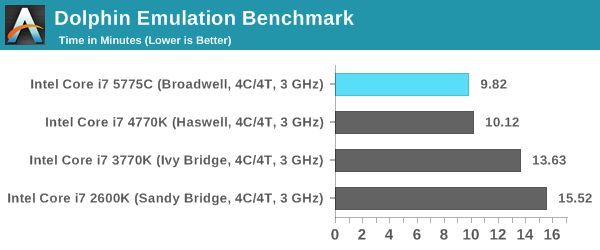
Cinebench R15
Cinebench is a benchmark based around Cinema 4D, and is fairly well known among enthusiasts for stressing the CPU for a provided workload. Results are given as a score, where higher is better.
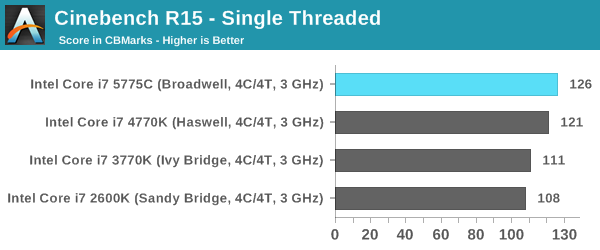
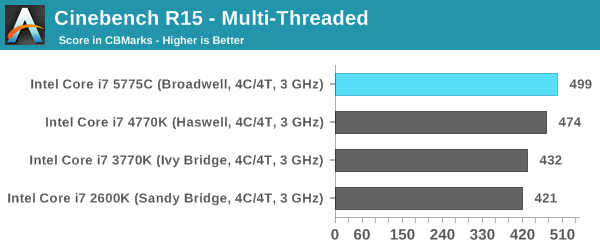
Point Calculations – 3D Movement Algorithm Test: link
3DPM is a self-penned benchmark, taking basic 3D movement algorithms used in Brownian Motion simulations and testing them for speed. High floating point performance, MHz and IPC wins in the single thread version, whereas the multithread version has to handle the threads and loves more cores. For a brief explanation of the platform agnostic coding behind this benchmark, see my forum post here.
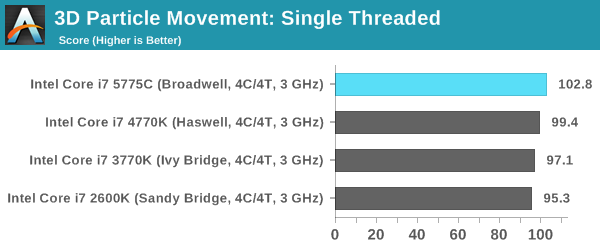
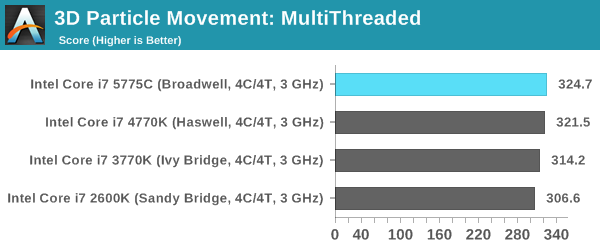
Compression – WinRAR 5.0.1: link
Our WinRAR test from 2013 is updated to the latest version of WinRAR at the start of 2014. We compress a set of 2867 files across 320 folders totaling 1.52 GB in size – 95% of these files are small typical website files, and the rest (90% of the size) are small 30 second 720p videos.
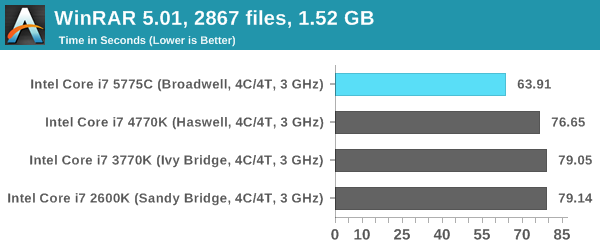
Image Manipulation – FastStone Image Viewer 4.9: link
Similarly to WinRAR, the FastStone test us updated for 2014 to the latest version. FastStone is the program I use to perform quick or bulk actions on images, such as resizing, adjusting for color and cropping. In our test we take a series of 170 images in various sizes and formats and convert them all into 640x480 .gif files, maintaining the aspect ratio. FastStone does not use multithreading for this test, and thus single threaded performance is often the winner.
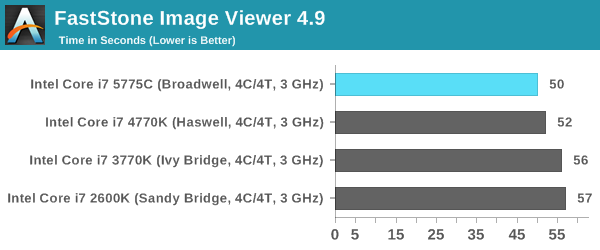
Video Conversion – Handbrake v0.9.9: link
Handbrake is a media conversion tool that was initially designed to help DVD ISOs and Video CDs into more common video formats. The principle today is still the same, primarily as an output for H.264 + AAC/MP3 audio within an MKV container. In our test we use the same videos as in the Xilisoft test, and results are given in frames per second.
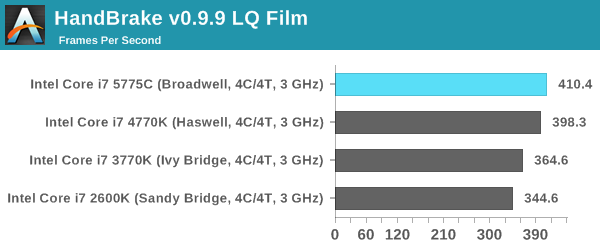
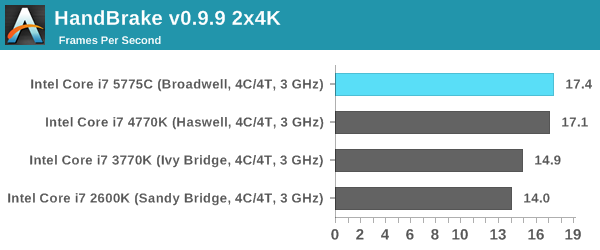
Rendering – PovRay 3.7: link
The Persistence of Vision RayTracer, or PovRay, is a freeware package for as the name suggests, ray tracing. It is a pure renderer, rather than modeling software, but the latest beta version contains a handy benchmark for stressing all processing threads on a platform. We have been using this test in motherboard reviews to test memory stability at various CPU speeds to good effect – if it passes the test, the IMC in the CPU is stable for a given CPU speed. As a CPU test, it runs for approximately 2-3 minutes on high end platforms.
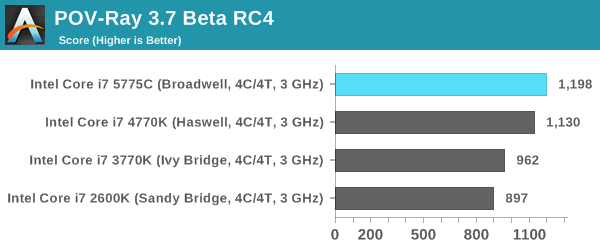
Synthetic – 7-Zip 9.2: link
As an open source compression tool, 7-Zip is a popular tool for making sets of files easier to handle and transfer. The software offers up its own benchmark, to which we report the result.
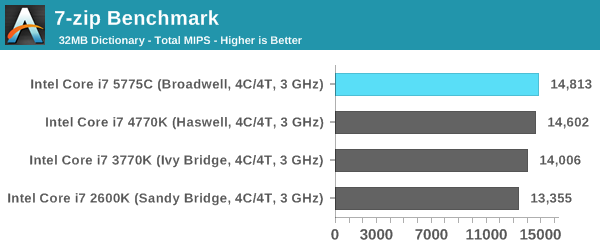
Overall: CPU IPC
*When this section was published initially, the timed benchmarks (those that rely on time rather than score) were caluclated incorrectly. The text has been updated to reflect the new calculations.
Removing WinRAR as a benchmark that obviously benefits from the eDRAM, we get an interesting look at how each generation has evolved over time. Taking Sandy Bridge (i7-2600K) as the base, we get the following:
As we can see, performance gains are everywhere although the total benefit is highly dependent on the benchmark in question. Cinebench in single threaded mode for example gives a 16.7% gain from Sandy Bridge to Broadwell, however Dolphin which is also single threaded gets a 58.1% improvement. Overall, a move from Sandy Bridge to Broadwell from an IPC perspective gives an average ~21% improvement. That is an increase in pure, raw throughput before considering frequency or any differentiator in core counts.
If we adjust this graph to show generation to generation improvement:
This graph shows something a little bit different. From these numbers:
Sandy Bridge to Ivy Bridge: Average ~5.0% Up
Ivy Bridge to Haswell: Average ~11.2% Up
Haswell to Broadwell: Average ~3.3% Up
Thus in a like for like environment, when eDRAM is not explicitly a driver for performance, Broadwell gives a 3.3% gain over Haswell. That’s a take home message worth considering, but it also affords the difference in performance between an architecture update and a node change.
Cycling back to our WinRAR test, things look a little different. Ivy Bridge to Haswell gives only a 3.2% difference, but the eDRAM in Broadwell slaps on another 23.8% performance increase, dropping the benchmark from 76.65 seconds to 63.91 seconds. When eDRAM counts, it counts a lot.


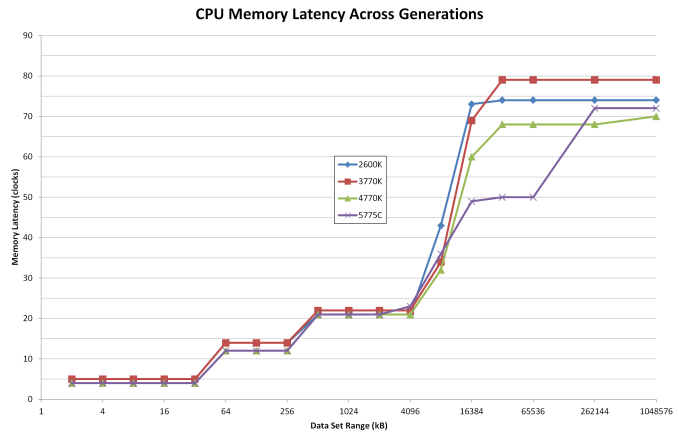
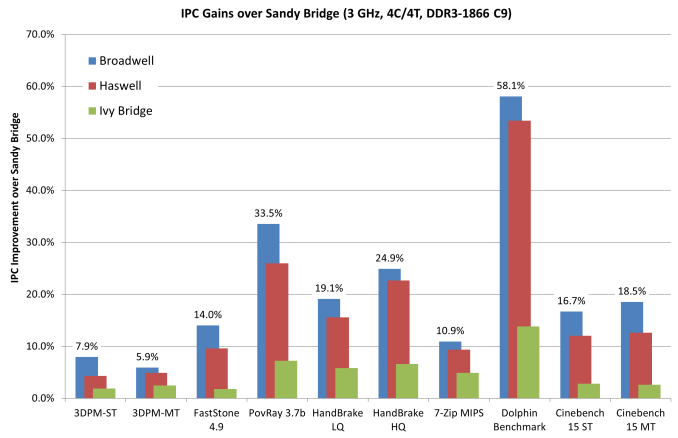
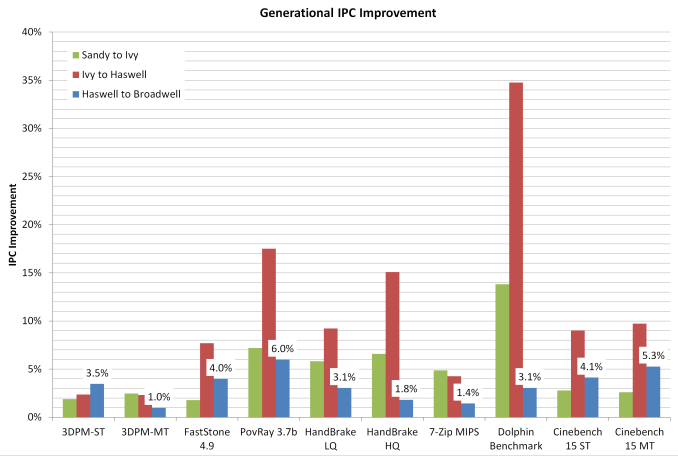








121 Comments
View All Comments
doggface - Tuesday, August 4, 2015 - link
Can intel please bring out a processor that destroys Sandy Bridge so that I don't have to hear all the smug comments every time they release a processor. I am so bored by them. Cant we talk about something interesting, like why is crystal well such a big focus for them when apparently all anyone wants in the enthusiast bracket is raw power?jrs77 - Tuesday, August 4, 2015 - link
And now look at all the PC-users who don't play games, but use their PCs for doing actual work.No tests of professional graphics software like Photoshop, Premiere, etc. No tests of professional audio-software like Reason, CuBase, etc. No tests of professional 3d-software that actually would benefit from the IrisPro and it's GPGPU-capabilities - and no, Cinebench is only for CPU-based rendering, so it doesn't count that much for stuff like flowsimulations done in Solidworks etc.
The i7-5775C is currently the best CPU outthere for small workstations, due to the very powerful IrisPro and the low TDP. You can build a very powerful rig in a box as small as the MacMini while still keeping the advantage of the 4C/8T CPU and an iGPU as powerful as a R7-250/GT740.
And this rig would only draw some 150W under full load, which is totally doable with a picoPSU.
I'm getting my i7-5775C finally delivered sometime next week, after waiting for 2 month, and I can finally build the rig I've allways wanted to combined with the following: Antec ISK110, picoPSU 160XT, Noctua NH-L9i, 2x SSD (256/512 GB) and 16GB DDR3.
Strapped to the back of my screen, allmost inaudible and very low power-draw.
This CPU is ment for SFF-workstations, but for this niche it's the best there is.
MrSpadge - Tuesday, August 4, 2015 - link
Thanks for the detailed review, Ian! As far as I know it's the most detailed out yet. And probably the last one, with Skylake hopefully just around the corner.Anyway, I would really like to see how low the power consumption of this chip can go. It's obviously optimized for mobile and low clocks, so pushing it to high clocks and high voltages (even the stock voltage is a lot for 14 nm!) is not showing it in its best light. When you tested the voltage scaling I would really like to see the minimum voltage needed to get to the lower speeds (you just left it at stock). How low can the power consumption of this chip become at ~1.0 V? Which clock speed hit does it take to get there? (btw: I run my 3770K at 4.0 GHz and a bit over 1.0 V, which is great for 24/7 load)
zlandar - Tuesday, August 4, 2015 - link
No reason to replace my 4 year-old i7-2600k for gaming. Kinda nutty since I just installed my 3rd video card on the same system.joanwa - Tuesday, August 4, 2015 - link
Concerning the Linux Performance, could one kindly ask for another software to be benchmarked? NAMD is nice, but the to my knowledge the bigger share of the scientific community in molecular dynamics uses Gromacs (www.gromacs.org), which is also much faster and better optimized for current Hardware (AVX2 support for instance, multiple GPU support) and has a bigger community around it.Morg72 - Tuesday, August 4, 2015 - link
I'm still rockin' an i7-950, ASUS P6X58D-E, 12gb DDR3 1600 and 2x 6870's in Crossfire. The only part showing me its age is the 6870's (probably going to upgrade next GPU gen). The rest runs everything I throw at it perfectly and that's at stock speed. I can always get a better CPU cooler and OC it for more longevity. Intel really needs to get things together. Hope Zen gives them a push.nagi603 - Wednesday, August 5, 2015 - link
4770k owner here... If this is how Intel upgrades, I won't be changing this baby out for a decade.Lazn_W - Wednesday, August 5, 2015 - link
My question is: Does the L4 cache help with multi threaded use? Say a home Hyper-V server lab environment? It might make the 5775C a better buy than one of the hex core 2111 socket CPUs..Jetpil0t - Thursday, August 6, 2015 - link
They should put out a multi-threaded K series 4 core with no IGP at a basement price for the more value minded people, gamers specifically, especially considering the main purpose of upgrading are the tertiary features on the motherboard. I doubt anyone with a Sandy is looking at this with any interest. Especially considering my Sandy board has PCIe3.0 and Sata 6Gbps and rocks 4-4.5 Ghz easily.SanX - Friday, August 7, 2015 - link
Big fart of Intel.Remember AMD Bulldozer?
Heads will be rolling.